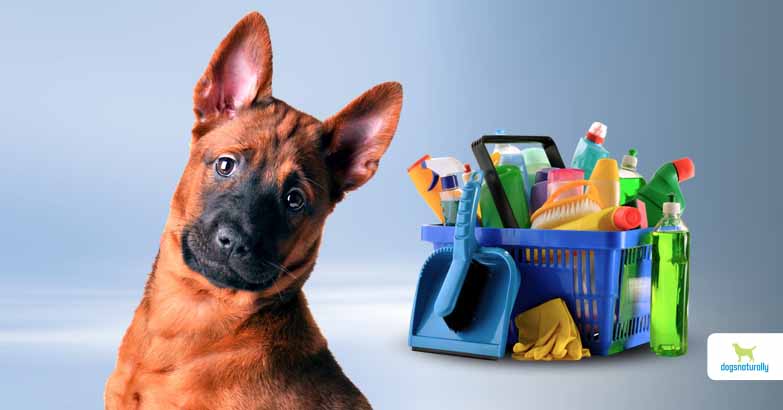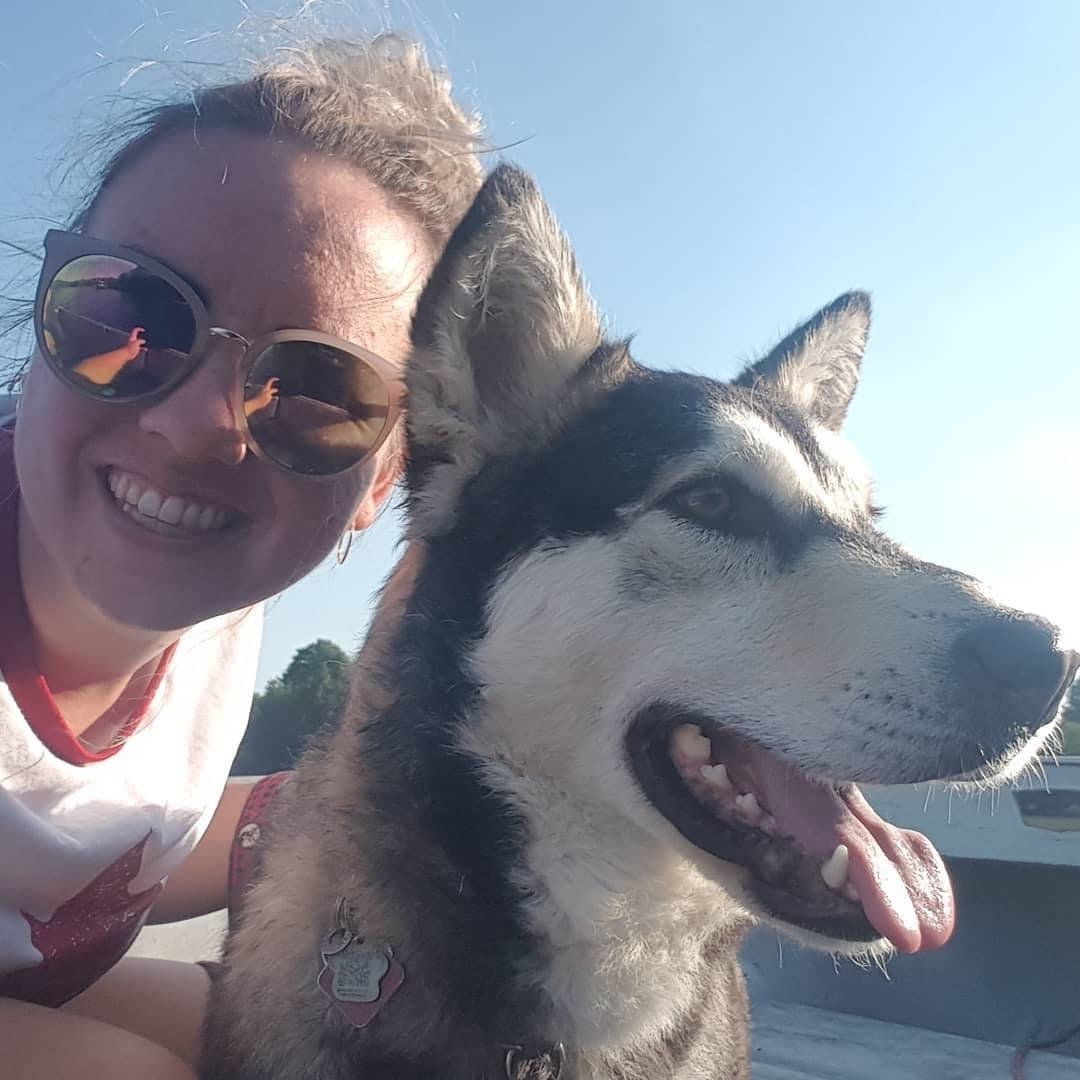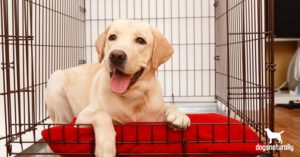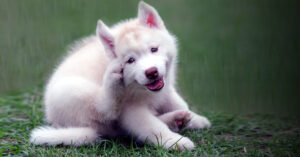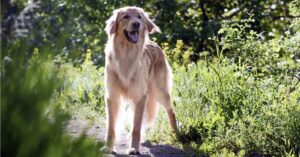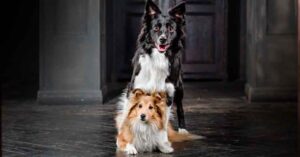Does your dog lie on the floor, the furniture, bathe in the bathtub, or even counter surf? Chances are, your answer is yes.
Have you thought about what you use to clean your home? Did you know your cleaning products could be damaging your dog’s health?
Many popular household cleaners contain ingredients that are highly toxic. They’re even worse for your dog, whose exposure is much higher than yours because she spends most of her time on or near the floor. That means she’s constantly breathing in these toxins or absorbing them through her paw pads and skin.
So… if you use chemical cleaning products, it’s time to change up your cleaning routine to protect your dog from harsh chemicals and instead use pet safe cleaners.
Toxic Ingredients To Avoid
Depending on what you use to clean your house, you could be forcing your dog to live in a toxic environment.
According to US Environmental Protection Agency (EPA) studies, the level of air pollution inside may be two to five times, and sometimes more than 100 times, higher than outdoor air pollution. That means if your dog spends most of her time inside, she’s breathing in toxic fumes all day long.
Think about it: you clean the house using a variety of sprays, washes and cleansers. Your dog sleeps on the floor, licks the floor and herself, and she can absorb toxins through her skin too. So she’s taking in these harmful chemicals much more than you are.
Even some cleaners that claim to be natural may include unhealthy substances for your dog.
And don’t forget that your dog’s sense of smell is up to 10,000 times more sensitive than your own. If your hardwood floor cleaner smells strong to you, how do you think your dog feels?
So … let’s look at toxic ingredients you need to avoid using in your home …
Ammonia (also called ammonium hydroxide)
Ammonia is a very popular cleaning agent – it’s one of the most commonly made chemicals in the US. It’s also highly toxic.
It’s a known irritant, particularly to your dog’s respiratory system. It can cause burning in the throat, nose and respiratory tract, which can lead to breathing issues. It can also irritate the skin and eyes. If your dog licks it, it can lead to burning inside his mouth, throat and stomach.
Ammonia is commonly found in:
- Oven cleaners
- Window cleaners
- Stainless steel cleaners
- Wax for hardwood floor
Bleach (chlorine)
We’ve all heard of using bleach for cleaning. It’s a strong disinfectant and many people use it either on its own or in products that have it as an ingredient …
But it’s dangerous for both humans and dogs.
Depending on how much bleach your dog swallows, it can cause vomiting, diarrhea, burns inside the mouth or throat, even seizures and shock. If she inhales the fumes, it can lead to respiratory illness.
Bleach is commonly found in:
- Scouring powders
- Toilet bowl cleaners
- Mildew removers
- Basic bleach
- Laundry detergent
- Dishwashing detergent
- All purpose cleansers
Phthalates
These are endocrine-disrupting chemicals used to make products smell good. And just because they’re not on the ingredient list, doesn’t mean they’re not in that bottle. “Fragrance” can mean phthalates (and usually does).
According to the National Toxicology Program, phthalates are “reasonably anticipated to be a human carcinogen based on sufficient evidence of carcinogenicity from studies in experimental animals.” In other words, evidence suggests they cause cancer.
Animal studies have found that phthalates can cause liver, testicular and pancreatic tumors.
Phthalates are commonly found in:
- Deodorizers
- All-purpose cleaners
And by the way, phthalates are also in other dog products like toys, crate mats, beds and more so check out what’s in these products before you buy them.
Glycol Ethers
Glycol ethers are another toxic chemical found in many household products.
EPA studies show that glycol ethers can cause liver, nerve and digestive damage. They’ve also been linked to lung damage, anemia and kidney damage in both animals and humans.
Glycol ethers are commonly found in:
- All purpose cleaners
- Spot removers
- Carpet cleaners
- Glass cleaners
- Liquid soaps
Also watch out for it in so-called “natural” cleansers.
Formaldehyde
Probably best known as an embalming agent, formaldehyde is also found in household cleaning products. When it reaches room temperature it’s released into the air, inhaled by your dog and absorbed into her skin.
It’s a severe eye and skin irritant, can decrease respiratory rate and decrease nerve response rate.
It’s recognized by the EPA as a carcinogen.
Formaldehyde is commonly found in:
- General household cleaners
- Plug-in fragrances
- Paper towels
- Hand soap
- Pet shampoo
Many things like new carpets and upholstered furniture are often treated with formaldehyde too, so find out about these before you buy!
1,4-Dioxane
1,4-Dioxane, which is classified as Ether, is a byproduct of the manufacturing process, used mainly with chemicals, plastics, pesticides and cosmetics. The FDA has recommended that manufacturers to remove 1,4 Dioxane from their products it’s not required by Federal Law so not all companies have followed this recommendation.
The CDC reports that breathing it in, swallowing it, or having skin contact with it primarily affects the kidneys and liver, causing irritation. Studies also show that 1,4-Dioxane can cause cancer.
1,4-Dioxane is commonly found in:
- Laundry detergent
- Dryer sheets
- Cosmetics
- Paint and varnishes
And, because it’s a byproduct, it’s usually not listed on the label. So do your homework and look for an organic, natural alternative. At the very least, don’t use products with this ingredient for your dog laundry (beds, towels, etc).
All these ingredients are bad for your dog, so it’s important to revamp your cleaning routine to make sure they’re not on the list. If you’re not sure, the Environmental Working Group’s Guide To Healthy Cleaning is a really good resource to look them up.
Even some so-called “natural” cleaners may include things you don’t want around your dog. Don’t trust the “natural” label unless you’ve looked up the ingredients. “Natural” is a marketing term, not a guarantee of safety.
4 Recipes For Pet Safe Cleaners
To save yourself the headache (and the risks to your dog), just make your own pet safe cleaners. All of these pet safe household cleaners use ingredients that you probably already have in your cupboards!
Pet Safe Wood Floor Cleaner
Your dog walks around and sleeps on the floor. Then she grooms her paws. Do you really want her licking chemicals all day long? Use this cleaner on wood, ceramic, linoleum or vinyl. You never have to worry about your dog sleeping on this floor.
Recipe
Mix 1 cup of vinegar into 1 liter of water and mop as usual. You don’t even need to rinse.
You can also use this as an all-purpose cleaner.
Baking Soda Scrub
This heavy-duty scrub is the perfect bathroom cleaner. Use it in the tub and toilet for those tough stains. It’s a good replacement for the toxic toilet bowl cleaners that pose a real threat (especially for dogs who treat the toilet like a water fountain).
You can also use it on countertops, pots and pans, and floors.
Recipe
Combine equal parts of these ingredients …
- Baking soda
- Warm water
- Salt
Mix well to create a thick paste. Use the paste to scrub surfaces with a sponge, then rinse well with warm water.
TIP: Baking soda is also great for removing stains. If you spill something on the floor, sprinkle some baking soda right on the spot. Let it sit for an hour to absorb the moisture, then vacuum thoroughly. This will also help remove odors, which makes it ideal for pet stains.
Pet Safe All-Purpose Cleaner
Apple cider vinegar, water and lemon juice are all it takes to disinfect pretty much any surface in your house.
Recipe
Mix one part vinegar and four parts water in a spray bottle. Add some fresh lemon juice to the mix and shake well.
To disinfect wood cutting boards, rub a cut lemon over the surface. Let the lemon juice sit for a few minutes and then wipe them clean.
If stains are really tough, sprinkle a little salt on the counter first and scrub the area with a half a lemon. Wipe clean. This pet safe disinfectant not only works, it also smells great.
Pet Safe Furniture Polish
Furniture polish can be a major offender when it comes to unsafe cleaning products and your dog.
Most contain petroleum distillates and nitrobenzene, which are both toxic.
Recipe
To make your own, mix 1/4 cup of olive oil, 4 tbsp apple cider vinegar and 2 tsp of lemon juice.
Use this mixture just like you would apply regular polish.
BONUS: Use Plants To Purify The Air
It can be tempting to try and use aerosol sprays or air fresheners to get rid of the “doggy” smells or other odors in your home. But these are usually full of (you guessed it) chemicals.
Air purifying plants do the double duty of cleaning the air and helping to remove odors … so you can ditch those sprays.
Here are a few that are safe for your dog:
- Money tree
- Spider plant
- Boston fern
- Areca Palm
RELATED: Find out why artificial fragrance oils aren’t safe for your dog …
If you’re here, it’s probably because you’re always trying to do the best you can for your dog’s health. You feed fresh, nutritious meals, add whole food supplements, keep pharmaceuticals to a minimum and assess all information before making decisions about your dog’s health. You even bathe your dog with a safe, all-natural shampoo.
Add pet safe cleaners to that list. They’re much safer for your dog – and the environment.

